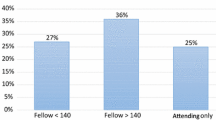Abstract
Background
It has been demonstrated that prolonged colonoscopic withdrawal times (WT; >6 min) are beneficial for the adenoma detection rate (ADR) for experienced endoscopists. There are little data, however, to guide the appropriate colonoscopic withdrawal times for trainees. The purpose of this study was to determine whether there is a relationship between WTs and ADR for first-year fellows training in colonoscopy.
Methods
This is a prospective study of first-year gastroenterology fellows at a single academic teaching hospital who documented each colonoscopy with a self-report form over the course of an academic year (March 2010 to February 2011). The internal policy for the trainees was to have at least a 6-min withdrawal time for each colonoscopy.
Results
Four first-year fellows in gastroenterology at an academic medical center completed self-reports for 1,210 colonoscopies. Mean WT was 10.2 ± 3.4 min. The aggregate polyp detection rate was 33.2% and the aggregate ADR was 22.3%. For colonoscopies with WT < 10 min, ADR was 9.5%, and for colonoscopies with WT ≥ 10 min, ADR was 32.3% (p < 0.001). When the quality indicator of 25% goal ADR for males and 15% goal ADR for females is applied, this aggregate rate is achieved for both sexes for screening colonoscopies (n = 676) with WT ≥ 10 min.
Conclusions
First-year trainees had a significantly higher ADR if their colonoscopic WT is ≥ 10 min.




Similar content being viewed by others
References
Dafnis G, Granath F, Pahlman L, Hannuksela H, Ekbom A, Blomqvist P (2001) The impact of endoscopists’ experience and learning curves and interendoscopist variation on colonoscopy completion rates. Endoscopy 33:511–517
Marshall JB (1995) Technical proficiency of trainees performing colonoscopy: a learning curve. Gastrointest Endosc 42:287–291
Tassios PS, Ladas SD, Grammenos I, Demertzis K, Raptis SA (1999) Acquisition of competence in colonoscopy: the learning curve of trainees. Endoscopy 31:702–706
Lee SH, Chung IK, Kim SJ et al (2008) An adequate level of training for technical competence in screening and diagnostic colonoscopy: a prospective multicenter evaluation of the learning curve. Gastrointest Endosc 67:683–689
Aslinia F, Uradomo L, Steele A, Greenwald BD, Raufman JP (2006) Quality assessment of colonoscopic cecal intubation: an analysis of 6 years of continuous practice at a university hospital. Am J Gastroenterol 101:721–731
Froehlich F, Wietlisbach V, Gonvers JJ, Burnand B, Vader JP (2005) Impact of colonic cleansing on quality and diagnostic yield of colonoscopy: the European Panel of Appropriateness of Gastrointestinal Endoscopy European multicenter study. Gastrointest Endosc 61:378–384
Harewood GC, Sharma VK, de Garmo P (2003) Impact of colonoscopy preparation quality on detection of suspected colonic neoplasia. Gastrointest Endosc 58:76–79
Rex DK, Bond JH, Winawer S et al (2002) Quality in the technical performance of colonoscopy and the continuous quality improvement process for colonoscopy: recommendations of the U.S. Multi-Society Task Force on Colorectal Cancer. Am J Gastroenterol 97:1296–1308
Vicari J (2009) The influence of timing of colonoscopy on adenoma detection: is timing everything? Am J Gastroenterol 104:1666–1667
Sanduleanu S, Rondagh EJ, Masclee AA (2010) Development of expertise in the detection and classification of non-polypoid colorectal neoplasia: experience-based data at an academic GI unit. Gastrointest Endosc Clin N Am 20:449–460
Rex DK, Petrini JL, Baron TH et al (2006) Quality indicators for colonoscopy. Am J Gastroenterol 101:873–885
Rex DK, Petrini JL, Baron TH et al (2006) Quality indicators for colonoscopy. Gastrointest Endosc 63:S16–S28
Rex DK (2006) Maximizing detection of adenomas and cancers during colonoscopy. Am J Gastroenterol 101:2866–2877
Kaminski MF, Regula J, Kraszewska E et al (2010) Quality indicators for colonoscopy and the risk of interval cancer. N Engl J Med 362:1795–1803
Barclay RL, Vicari JJ, Doughty AS, Johanson JF, Greenlaw RL (2006) Colonoscopic withdrawal times and adenoma detection during screening colonoscopy. N Engl J Med 355:2533–2541
Barclay RL, Vicari JJ, Greenlaw RL (2008) Effect of a time-dependent colonoscopic withdrawal protocol on adenoma detection during screening colonoscopy. Clin Gastroenterol Hepatol 6:1091–1098
Sawhney MS, Cury MS, Neeman N et al (2008) Effect of institution-wide policy of colonoscopy withdrawal time ≥ 7 minutes on polyp detection. Gastroenterology 135:1892–1898
Chen SC, Rex DK (2007) Endoscopist can be more powerful than age and male gender in predicting adenoma detection at colonoscopy. Am J Gastroenterol 102:856–861
Rex DK (2000) Colonoscopic withdrawal technique is associated with adenoma miss rates. Gastrointest Endosc 51:33–36
Spier BJ, Benson M, Pfau PR, Nelligan G, Lucey MR, Gaumnitz EA (2010) Colonoscopy training in gastroenterology fellowships: determining competence. Gastrointest Endosc 71:319–324
McCashland TM, Brand R, Lyden E, de Garmo P (2001) Gender differences in colorectal polyps and tumors. Am J Gastroenterol 96:882–886
Saunders BP, Fukumoto M, Halligan S et al (1996) Why is colonoscopy more difficult in women? Gastrointest Endosc 43:124–126
Schoenfeld P, Cash B, Flood A et al (2005) Colonoscopic screening of average-risk women for colorectal neoplasia. N Engl J Med 352:2061–2068
Disclosures
Mark A. Gromski, Christopher A. Miller, Suck-Ho Lee, Eun Seo Park, Tae Hoon Lee, Sang-Heum Park, Il-Kwun Chung, Sun-Joo Kim, and Young Hwangbo have no conflicts of interest or financial ties to disclose.
Author information
Authors and Affiliations
Corresponding author
Rights and permissions
About this article
Cite this article
Gromski, M.A., Miller, C.A., Lee, SH. et al. Trainees’ adenoma detection rate is higher if ≥10 minutes is spent on withdrawal during colonoscopy. Surg Endosc 26, 1337–1342 (2012). https://doi.org/10.1007/s00464-011-2033-2
Received:
Accepted:
Published:
Issue Date:
DOI: https://doi.org/10.1007/s00464-011-2033-2




